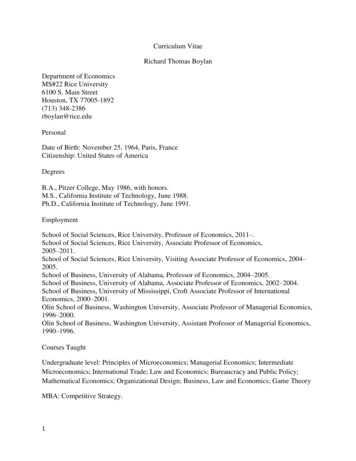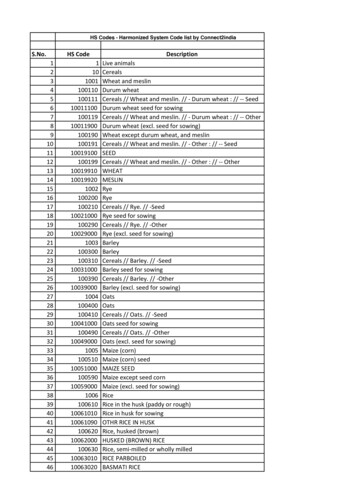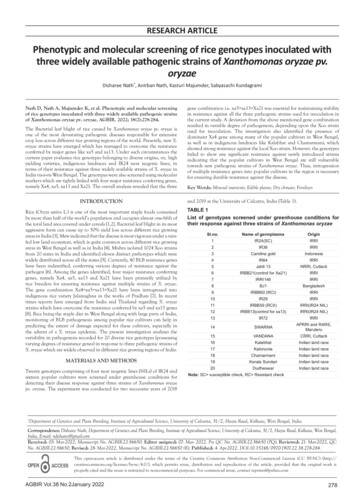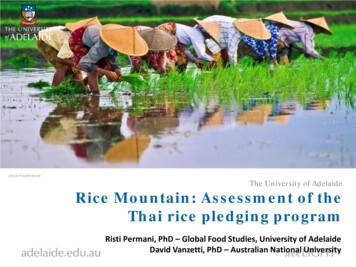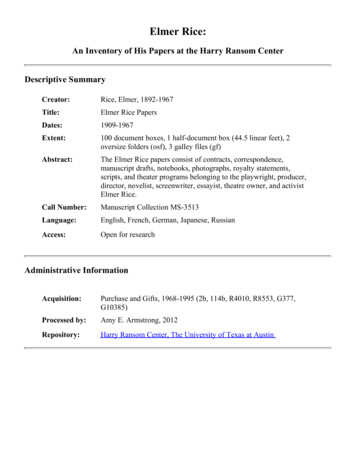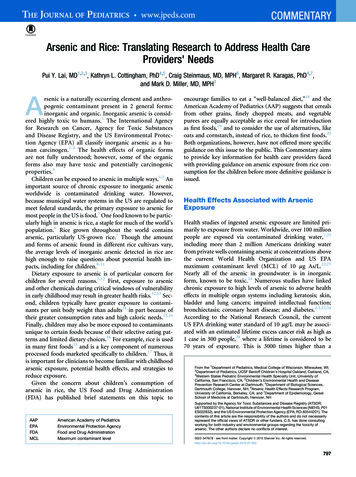
Transcription
“Climate Action Planning at Rice University”Richard R. JohnsonAdmin. Center for Sustainability and Energy Management27 April 2016
Mid 2000s: Climate Change Reaches Mainstream
Rice University Commits to Go Climate Neutral
TopicsPart 1: Higher Ed Institutions and Climate Change Progress Across Higher EdPart 2: Rice University Carbon Footprint andPlans to Become Carbon Neutral Rice Scope 1 Emissions Rice Scope 2 Emissions Rice Scope 3 Emissions Carbon Sequestration
Part 1: Higher Ed InstitutionsCombat Climate Change
ACUPCC Progress Report, Sept 2014Step 1: Sign the Commitment 684 signatory institutions, representing about7.5M students (over 1/3 of higher education)Step 2: Conduct and Emissions Inventory 629 institutions have submitted at least oneemissions inventoryStep 3: Develop a Climate Action Plan 537 Climate Action Plans submitted Typical target carbon neutral date: 2045-2050 70 institutions (13%) have set a target by no laterthan 2025.Step 4: Implement Plan 315 campuses have shown an emissions reduction(average of 19%)Source: ACUPCC, -Progress/Summary-September2014.pdf
Part 2: Rice University’s CarbonFootprint and Plans to BecomeCarbon Neutral
Rice Integrated Climate & Energy Master PlanUSE LESSBUY GREENSEQUESTER CARBON
“Scopes” of EmissionsSource: https://saylordotorg.github.io/text the-sustainable-business-case-book/section 08/d6f6e72c6167122a739893205efed7cc.jpg
9% Reduction in Rice CO2 Emissions in FY15Sources: UNIV 303, 1999; CHBE/ENST 281, 2007-2012
9% Reduction in Rice CO2 Emissions in FY15Rice’s emissions per sf and the distribution by scope are fairly typical fordoctorate-granting universitiesSources: UNIV 303, 1999; CHBE/ENST 281, 2007-2013; ACSEM
Rice Scope 1 Emissions
Scope 1
Plant Optimization Project: Key QuestionAt any given time, what equipmentshould the plant operators run inorder to meet campus energy needsas cheaply as possible?
Rice Scope 2 Emissions
Scope 2
Rice Greens its Electricity Procurement at No Increase in Cost!
Rice UniversitySolar: 7.25%Solar Face-Off: Rice Vs. GermanyGermany
Jones South Solar
Texas Electricity Continues to Get “Cleaner”ELECTRIC RELIABILITY COUNCIL OF TEXASENERGY BY FUEL TYPE FOR 2016Updated 4/7/2016ENERGY BY FUEL TYPE, MWhFuel TypesNatural GasCoalJan*12,720,7866,853,636FebMar10,199,407 A#N/A#N/A#N/A#N/A145,364Total27,538,06823,585,055 40,067Net DC/BLTENERGY BY FUEL TYPE, PERCENTFuel TypesJan*Natural et A#N/A#N/A#N/A#N/A#N/A#N/A100.0%*Information for 2016 for this month has been updated based on final settlements.Companies are not required to notify ERCOT when their dual fuel units are using secondary fuel. Therefore, values shown here are calculated based on primary fuel type and may not exactly reflect the fuels being used by dualfuel units. Dual fuel units are included in the category of their primary fuel.A positive value in the 'Net DC/BLT' row indicates import of power, negative indicates export."Other" includes solar, petroleum coke, landfill gas, biomass solids, biomass gases, and any unknown fuel.Source: ERCOT
Demand-Side Energy Management
Rice Scope 3 Emissions
Scope 3: About 10% of the Total in FY15** - This represents a collection of first-order approximations based on a series of class projectsover a span of several years.Sources: UNIV 303, 1999; CHBE/ENST 281, 2007-2012
Scope 3: StatusCategoryYear(s) ConductedCommentsFaculty/Staff Air Travel2006, 2013In footprintStudent Air Travel2006, 2010In footprintFaculty/StaffCommuting2006, 2010, 2013In footprintStudent Commuting2006, 2010, 2013In footprintSolid Waste / Recycling2006In footprintMeat Consumption2012, 2016Not part of ACUPCC;Not in Rice footprintBuilding Materials (RecCenter)2013Not part of ACUPCC;Not in Rice footprintFood Transportation2011, 2016Not part of ACUPCC;Not in Rice footprintFood Production2011, 2016Not part of ACUPCC;Not in Rice footprintWater Consumption2009Not part of ACUPCC;Not in Rice footprint
Carbon Sequestration
The Rice Land Lumber Company
Q: How can the construction of a newbuilding be “good” for the environment?
Design for the Carbon CycleSource: Dr. Ning Zeng, University of Maryland, Department of Atmospheric and Oceanic Science
Building Materials: CO2 Storage vs. EmissionsAs long as the wood does not burn or decompose, the carbon remains locked(or sequestered) inside the wood.By comparison, creating 1 m³ of concrete causes 1,400 kg of CO2 emissions,and 1 ton of steel causes 3,629 kg of CO2 emissions to the atmosphere.
Design With CLT
Largest CLT Project in the World (by Volume) 122 ApartmentsOnly 2 tons of steel in entire project80-90% reduction in deliveries, 1 story completed every 3 weeks3,200 metric tonnes of CO2 sequestration
StudentHousing inHeidelberg265 studentsReady for occupancy5 months after slabcompletion3,000 tons of CO2sequesteredSource: LiWood
What If ?
A Few Thoughts About RICEMaP The Climate Action Plan should be viewed as a starting point. Scope 3 emissions and projected emissions from new growthare “covered” by carbon sequestration from the Rice LandLumber Company property. Is this the right approach? New opportunities continue to emerge How comfortable are we with the greenhouse gas inventory?Does it include everything it needs to include?
Questions?Email: sustainability@rice.eduWeb: http://sustainability.rice.eduFollow Sustainability at Rice University on Facebook
ENERGY BY FUEL TYPE FOR 2016 ENERGY BY FUEL TYPE, MWh ENERGY BY FUEL TYPE, PERCENT Companies are not required to notify ERCOT when their dual fuel units are using secondary fuel. Therefore, values shown here are calculated based on primary fuel type and may not exactly reflect the fuels being used by dual fuel units.





